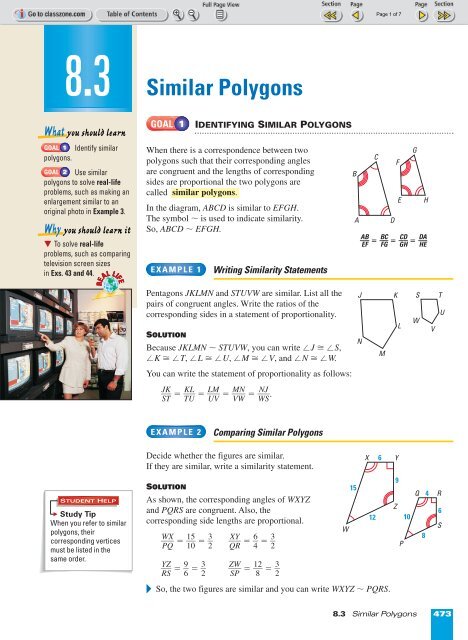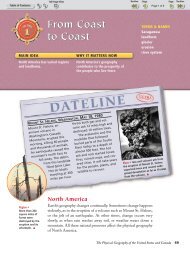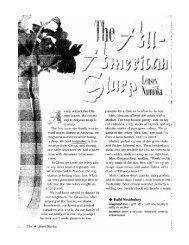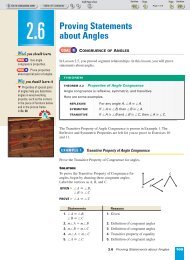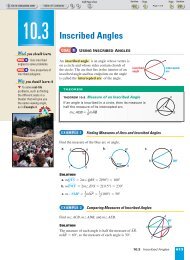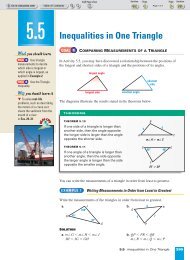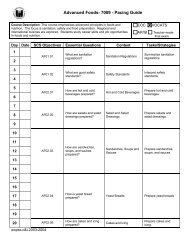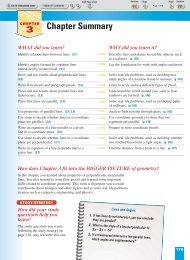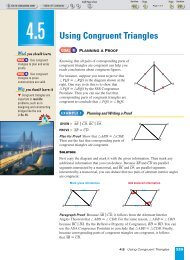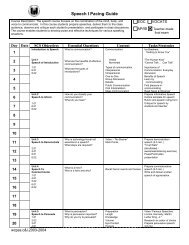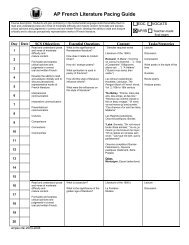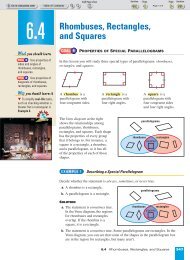Similar Polygons - Nexuslearning.net
Similar Polygons - Nexuslearning.net
Similar Polygons - Nexuslearning.net
Create successful ePaper yourself
Turn your PDF publications into a flip-book with our unique Google optimized e-Paper software.
8.3<br />
What you should learn<br />
GOAL 1 Identify similar<br />
polygons.<br />
GOAL 2 Use similar<br />
polygons to solve real-life<br />
problems, such as making an<br />
enlargement similar to an<br />
original photo in Example 3.<br />
Why you should learn it<br />
To solve real-life<br />
problems, such as comparing<br />
television screen sizes<br />
in Exs. 43 and 44.<br />
REAL<br />
REAL LIFE<br />
LIFE<br />
STUDENT HELP<br />
Study Tip<br />
When you refer to similar<br />
polygons, their<br />
corresponding vertices<br />
must be listed in the<br />
same order.<br />
<strong>Similar</strong> <strong>Polygons</strong><br />
GOAL 1<br />
IDENTIFYING SIMILAR POLYGONS<br />
When there is a correspondence between two<br />
polygons such that their corresponding angles<br />
are congruent and the lengths of corresponding<br />
sides are proportional the two polygons are<br />
called similar polygons.<br />
In the diagram, ABCD is similar to EFGH.<br />
The symbol ~ is used to indicate similarity.<br />
So, ABCD ~ EFGH.<br />
EXAMPLE 1<br />
Writing <strong>Similar</strong>ity Statements<br />
Pentagons JKLMN and STUVW are similar. List all the<br />
pairs of congruent angles. Write the ratios of the<br />
corresponding sides in a statement of proportionality.<br />
SOLUTION<br />
Because JKLMN ~ STUVW, you can write J £ S,<br />
K £ T, L £ U, M £ V, and N £ W.<br />
You can write the statement of proportionality as follows:<br />
JK<br />
ST<br />
= KL<br />
= <br />
TU<br />
LM<br />
= <br />
UV<br />
MN<br />
NJ<br />
= . VW WS<br />
EXAMPLE 2<br />
Comparing <strong>Similar</strong> <strong>Polygons</strong><br />
Decide whether the figures are similar.<br />
If they are similar, write a similarity statement.<br />
SOLUTION<br />
As shown, the corresponding angles of WXYZ<br />
and PQRS are congruent. Also, the<br />
corresponding side lengths are proportional.<br />
WX<br />
= <br />
PQ<br />
15<br />
= <br />
10<br />
3<br />
2 XY<br />
= <br />
QR<br />
6<br />
= 3<br />
4 2 <br />
YZ<br />
= <br />
RS<br />
9<br />
W 2<br />
= 3 Z = 1 = <br />
6 2 SP<br />
8<br />
3<br />
2 <br />
So, the two figures are similar and you can write WXYZ ~ PQRS.<br />
W<br />
B<br />
15<br />
A<br />
N<br />
C<br />
D<br />
J K<br />
8.3 <strong>Similar</strong> <strong>Polygons</strong> 473<br />
F<br />
E<br />
X 6 Y<br />
12<br />
M<br />
Z<br />
9<br />
L<br />
P<br />
10<br />
G<br />
W<br />
H<br />
} AB<br />
} = }<br />
EF<br />
BC<br />
CD<br />
} = } } = }<br />
FG GH<br />
DA<br />
}<br />
HE<br />
S T<br />
q 4 R<br />
8<br />
V<br />
6<br />
S<br />
U
474 Chapter 8 <strong>Similar</strong>ity<br />
GOAL 2<br />
EXAMPLE 3<br />
REAL<br />
REAL LIFE<br />
LIFE<br />
USING SIMILAR POLYGONS IN REAL LIFE<br />
Comparing Photographic Enlargements<br />
POSTER DESIGN You have been asked to create a poster to advertise a<br />
field trip to see the Liberty Bell. You have a 3.5 inch by 5 inch photo that<br />
you want to enlarge. You want the enlargement to be 16 inches wide. How long<br />
will it be?<br />
SOLUTION<br />
5<br />
To find the length of the<br />
enlargement, you can compare 3.5<br />
the enlargement to the original<br />
measurements of the photo.<br />
x<br />
16<br />
in.<br />
x in.<br />
= 3.<br />
5 in.<br />
5 in.<br />
16<br />
x = • 5<br />
3.<br />
5<br />
x ≈ 22.9 inches<br />
16<br />
The length of the enlargement will be about 23 inches.<br />
. . . . . . . . . .<br />
If two polygons are similar, then the ratio of the lengths of two corresponding<br />
sides is called the In Example 2 on the previous page, the common<br />
ratio of 3<br />
scale factor.<br />
is the scale factor of WXYZ to PQRS.<br />
2<br />
EXAMPLE 4<br />
Using <strong>Similar</strong> <strong>Polygons</strong><br />
The rectangular patio around a pool is<br />
similar to the pool as shown. Calculate<br />
the scale factor of the patio to the pool,<br />
and find the ratio of their perimeters.<br />
SOLUTION<br />
Because the rectangles are similar, the<br />
scale factor of the patio to the pool is<br />
48 ft:32 ft, which is 3:2 in simplified form.<br />
The perimeter of the patio is 2(24) + 2(48) = 144 feet and the perimeter of the<br />
pool is 2(16) + 2(32) = 96 feet. The ratio of the perimeters is 144<br />
, or <br />
96<br />
3<br />
2 .<br />
48 ft<br />
. . . . . . . . . .<br />
Notice in Example 4 that the ratio of the perimeters is the same as the scale factor<br />
of the rectangles. This observation is generalized in the following theorem. You<br />
are asked to prove Theorem 8.1 for two similar rectangles in Exercise 45.<br />
32 ft<br />
Trip to the<br />
Liberty Bell<br />
16 ft<br />
March 24th<br />
Sign up today!<br />
24 ft
xy xy<br />
Using<br />
Algebra<br />
GUIDED PRACTICE<br />
Vocabulary Check ✓<br />
Concept Check ✓<br />
Skill Check ✓<br />
THEOREM<br />
THEOREM 8.1<br />
If two polygons are similar, then the ratio<br />
of their perimeters is equal to the ratios of<br />
their corresponding side lengths.<br />
If KLMN ~ PQRS, then<br />
KL<br />
= = <br />
PQ<br />
LM<br />
= <br />
QR<br />
MN<br />
= <br />
RS<br />
N<br />
N<br />
KL + LM + MN + NK<br />
<br />
K<br />
PQ + QR + RS + SP<br />
.<br />
SP<br />
EXAMPLE 5<br />
Using <strong>Similar</strong> <strong>Polygons</strong><br />
Quadrilateral JKLM is similar to<br />
quadrilateral PQRS.<br />
Find the value of z.<br />
SOLUTION<br />
Set up a proportion that contains PQ.<br />
KL JK<br />
= QR<br />
PQ<br />
Write proportion.<br />
15<br />
= <br />
6<br />
10<br />
<br />
z<br />
Substitute.<br />
z = 4 Cross multiply and divide by 15.<br />
1. If two polygons are similar, must they also be congruent? Explain.<br />
Decide whether the figures are similar. Explain your reasoning.<br />
2. 3.<br />
15<br />
In the diagram, TUVW ~ ABCD.<br />
4. List all pairs of congruent angles and write the<br />
statement of proportionality for the polygons.<br />
5. Find the scale factor of<br />
TUVW to ABCD.<br />
6. Find the length of TW Æ .<br />
7. Find the measure of TUV.<br />
8<br />
3<br />
10<br />
W<br />
K<br />
J 10<br />
M<br />
L<br />
K<br />
6<br />
89<br />
5<br />
82<br />
7<br />
87<br />
4<br />
M<br />
T 15 U<br />
23<br />
15<br />
10<br />
D<br />
6<br />
V<br />
S<br />
L<br />
89<br />
82<br />
A<br />
P<br />
12<br />
14<br />
102<br />
8.3 <strong>Similar</strong> <strong>Polygons</strong> 475<br />
q<br />
q<br />
6<br />
z<br />
R<br />
P<br />
R S<br />
9 B<br />
70<br />
C<br />
8
PRACTICE AND APPLICATIONS<br />
STUDENT HELP<br />
Extra Practice<br />
to help you master<br />
skills is on p. 817.<br />
STUDENT HELP<br />
HOMEWORK HELP<br />
Example 1: Exs. 8–10<br />
Example 2: Exs. 11–18<br />
Example 3: Exs. 19–30,<br />
43, 44<br />
Example 4: Exs. 19–30,<br />
46–48<br />
Example 5: Exs. 39–42<br />
476 Chapter 8 <strong>Similar</strong>ity<br />
WRITING SIMILARITY STATEMENTS Use the information given to list all<br />
pairs of congruent angles and write the statement of proportionality for<br />
the figures.<br />
8. ¤DEF ~ ¤PQR<br />
9. ⁄JKLM ~ ⁄WXYZ<br />
10. QRSTU ~ ABCDE<br />
DETERMINING SIMILARITY Decide whether the quadrilaterals are similar.<br />
Explain your reasoning.<br />
A B<br />
D 7<br />
C<br />
11. ABCD and FGHE 12. ABCD and JKLM<br />
13. ABCD and PQRS 14. JKLM and PQRS<br />
DETERMINING SIMILARITY Decide whether the polygons are similar. If so,<br />
write a similarity statement.<br />
15. E F 16.<br />
A B<br />
17. X<br />
A 6 B 18.<br />
6.75<br />
Z<br />
USING SIMILAR POLYGONS PQRS ~ JKLM.<br />
19. Find the scale factor of PQRS to JKLM.<br />
20. Find the scale factor of JKLM to PQRS.<br />
21. Find the values of w, x, and y.<br />
4<br />
D 4 C<br />
3.5<br />
22. Find the perimeter of each polygon.<br />
12<br />
9<br />
23. Find the ratio of the perimeter of PQRS to<br />
the perimeter of JKLM.<br />
8<br />
E F<br />
4<br />
H 2 G<br />
Y<br />
5<br />
H 5 G<br />
4.5<br />
C<br />
K L<br />
J 3 M<br />
T U<br />
W 6 V<br />
K<br />
20<br />
J<br />
118<br />
25<br />
5<br />
L<br />
R<br />
30<br />
75<br />
M<br />
K<br />
q<br />
88<br />
15<br />
4<br />
6<br />
P<br />
3<br />
S<br />
E F<br />
R 14 S<br />
65 105<br />
q 10 P<br />
L<br />
x<br />
J y M<br />
w<br />
4<br />
H 3 G<br />
q<br />
12<br />
R<br />
10<br />
P 16 S
STUDENT HELP<br />
HOMEWORK HELP<br />
Visit our Web site<br />
www.mcdougallittell.com<br />
for help with problem<br />
solving in Exs. 31–38.<br />
INTERNET<br />
FOCUS ON<br />
APPLICATIONS<br />
DIGITAL<br />
TELEVISION<br />
screens contain over 6 times<br />
as many pixels (the tiny dots<br />
that make up the picture) as<br />
standard analog screens.<br />
LIFE<br />
LIFE<br />
REAL<br />
REAL<br />
USING SIMILAR POLYGONS ⁄ABCD ~ ⁄EFGH.<br />
24. Find the scale factor of ⁄ABCD to ⁄EFGH.<br />
25. Find the length of EH Æ .<br />
26. Find the measure of G.<br />
27. Find the perimeter of ⁄EFGH.<br />
28. Find the ratio of the perimeter of ⁄EFGH to the perimeter of ⁄ABCD.<br />
DETERMINING SIMILARITY Decide whether the polygons are similar. If so,<br />
find the scale factor of Figure A to Figure B.<br />
29. 18<br />
110<br />
8<br />
30.<br />
18 A<br />
14 B<br />
70<br />
30<br />
18<br />
LOGICAL REASONING Tell whether the polygons are always,<br />
sometimes, or never similar.<br />
31. Two isosceles triangles 32. Two regular polygons<br />
33. Two isosceles trapezoids 34. Two rhombuses<br />
35. Two squares 36. An isosceles and a scalene triangle<br />
37. Two equilateral triangles 38. A right and an isosceles triangle<br />
xy xy<br />
USING ALGEBRA The two polygons are similar. Find the values of x and y.<br />
39. 40.<br />
x 2<br />
15<br />
6<br />
10<br />
41. 42.<br />
27<br />
21<br />
y 3<br />
39<br />
x 6<br />
TV SCREENS In Exercises 43 and 44, use the following information.<br />
Television screen sizes are based on the length of the diagonal of the screen. The<br />
aspect ratio refers to the length to width ratio of the screen. A standard 27 inch<br />
analog television screen has an aspect ratio of 4:3. A 27 inch digital television<br />
screen has an aspect ratio of 16:9.<br />
43. Make a scale drawing of each television screen. Use proportions and<br />
the Pythagorean Theorem to calculate the lengths and widths of the<br />
screens in inches.<br />
44. Are the television screens similar? Explain.<br />
y<br />
8<br />
18<br />
6<br />
D<br />
22<br />
x<br />
(y 73)<br />
30<br />
A B<br />
6<br />
6<br />
116<br />
A<br />
60<br />
18<br />
H<br />
61<br />
x 4<br />
116<br />
5<br />
y<br />
12<br />
8.3 <strong>Similar</strong> <strong>Polygons</strong> 477<br />
C<br />
3<br />
E<br />
G<br />
4<br />
4<br />
F<br />
B<br />
4
Test<br />
Preparation<br />
★ Challenge<br />
EXTRA CHALLENGE<br />
www.mcdougallittell.com<br />
478 Chapter 8 <strong>Similar</strong>ity<br />
45. PROOF Prove Theorem 8.1 for two<br />
similar rectangles.<br />
GIVEN ABCD ~ EFGH<br />
perimeter<br />
of<br />
ABCD<br />
PROVE = <br />
perimeter<br />
of<br />
EFGH<br />
AB<br />
EF<br />
<br />
46. SCALE The ratio of the perimeter of WXYZ to the perimeter<br />
of QRST is 7.5: 2. Find the scale factor of QRST to WXYZ.<br />
47. SCALE The ratio of one side of ¤CDE to the corresponding side of similar<br />
¤FGH is 2:5. The perimeter of ¤FGH is 28 inches. Find the perimeter<br />
of ¤CDE.<br />
48. SCALE The perimeter of ⁄PQRS is 94 centimeters. The perimeter of<br />
⁄JKLM is 18.8 centimeters, and ⁄JKLM ~ ⁄PQRS. The lengths of the<br />
sides of ⁄PQRS are 15 centimeters and 32 centimeters. Find the scale factor<br />
of ⁄PQRS to ⁄JKLM, and the lengths of the sides of ⁄JKLM.<br />
49. MULTI-STEP PROBLEM Use the similar figures shown. The scale factor of<br />
Figure 1 to Figure 2 is 7:10.<br />
a. Copy and complete the table.<br />
AB BC CD DE EA<br />
Figure 1 ? ? ? ? ?<br />
Figure 2 6.0 3.0 5.0 2.0 4.0<br />
b. Graph the data in the table. Let x represent the length of a side in Figure 1<br />
and let y represent the length of the corresponding side in Figure 2.<br />
Determine an equation that relates x and y.<br />
c. ANALYZING DATA The equation you obtained in part (b) should be<br />
linear. What is its slope? How does its slope compare to the scale factor?<br />
TOTAL ECLIPSE Use the following information in Exercises 50–52.<br />
From your perspective on Earth during a total eclipse of the sun, the moon is<br />
directly in line with the sun and blocks the sun’s rays. The ratio of the radius of<br />
the moon to its distance to Earth is about the same as the ratio of the radius of the<br />
sun to its distance to Earth.<br />
Distance between Earth and the moon: 240,000 miles<br />
Distance between Earth and the sun: 93,000,000 miles<br />
Radius of the sun: 432,500 miles<br />
50. Make a sketch of Earth, the moon, and the sun<br />
during a total eclipse of the sun. Include the<br />
given distances in your sketch.<br />
51. Your sketch should contain some similar<br />
triangles. Use the similar triangles in your<br />
sketch to explain a total eclipse of the sun.<br />
52. Write a statement of proportionality for the<br />
similar triangles. Then use the given distances<br />
to estimate the radius of the moon.<br />
A B<br />
E<br />
D<br />
w<br />
D L C<br />
C<br />
A B<br />
Figure 1<br />
E F<br />
H k p L G<br />
2<br />
E<br />
4<br />
D<br />
5<br />
k p w<br />
C<br />
3<br />
A 6<br />
Figure 2<br />
B
MIXED REVIEW<br />
FINDING SLOPE Find the slope of the line that passes through the given<br />
points. (Review 3.6 for 8.4)<br />
53. A(º1, 4), B(3, 8) 54. P(0, º7), Q(º6, º3) 55. J(9, 4), K(2, 5)<br />
56. L(º2, º3), M(1, 10) 57. S(–4, 5), T(2, º2) 58. Y(º1, 6), Z(5, º5)<br />
FINDING ANGLE MEASURES Find the value of x. (Review 4.1 for 8.4)<br />
59. A<br />
60. B<br />
61.<br />
A<br />
83<br />
x<br />
5x<br />
41<br />
B C<br />
SOLVING PROPORTIONS Solve the proportion. (Review 8.1)<br />
x 6<br />
62. = 2 <br />
9 7<br />
63. 4<br />
y = 2<br />
<br />
19<br />
5<br />
64. = <br />
24<br />
25<br />
<br />
z<br />
4<br />
65. = b<br />
13<br />
8 66. 11<br />
= <br />
x + 2<br />
9<br />
<br />
x<br />
+7 4x<br />
67. 3x = 5 6<br />
QUIZ 1 Self-Test for Lessons 8.1–8.3<br />
Solve the proportions. (Lesson 8.1)<br />
p<br />
1. = 2 2. 5<br />
15<br />
3 7 = 3. 20<br />
4 6<br />
= 1 <br />
d<br />
2x º6 x<br />
Find the geometric mean of the two numbers. (Lesson 8.2)<br />
4. 7 and 63 5. 5 and 11 6. 10 and 7<br />
In Exercises 7 and 8, the two polygons are similar. Find the value of x. Then<br />
find the scale factor and the ratio of the perimeters. (Lesson 8.3)<br />
7. 8.<br />
x 1<br />
3<br />
8<br />
C<br />
6<br />
(9x 1)<br />
COMPARING PHOTO SIZES Use the following information. (Lesson 8.3)<br />
You are ordering your school pictures. You decide to order one 8 ª 10 (8 inches<br />
by 10 inches), two 5 ª 7’s (5 inches by 7 inches), and 24 wallets 2 1<br />
inches by<br />
4<br />
3 1<br />
inches.<br />
4<br />
9. Are any of these sizes similar to each other?<br />
10. Suppose you want the wallet photos to be similar to the 8 ª 10 photo. If the<br />
wallet photo were 2 1<br />
inches wide, how tall would it be?<br />
2<br />
x<br />
C<br />
45<br />
3x<br />
20<br />
(6x 6)<br />
105<br />
B<br />
8.3 <strong>Similar</strong> <strong>Polygons</strong> 479<br />
x<br />
A


